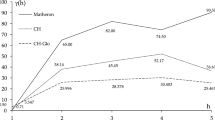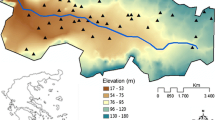Abstract
Prediction of longitudinal dispersion coefficient (LDC) is still a novel topic for both environmental and water sciences due to its practical importance. In this study, the appraisal of LDC is considered as a spatial modelling problem and the analyses are carried out by regression kriging. Since LDC prediction includes some geometrical (spatial) parameters, the analyses have been performed such that it takes spatial variability of data into account. The modelling procedure consists of two stages. In the first stage, spatial variables are analyzed via multi-linear regression technique and deterministic relationships are identified. In the second stage, based on the spatial auto-correlations of the residuals, the regression-based kriging procedure is applied. The capacity and accuracy level of the method has been compared with former models. As a consequence, the applications revealed that analyzing hydraulic and geometrical parameters with spatially correlated errors is a convenient approach for evaluating LDC in a hydrological system.








Similar content being viewed by others
References
Ahsan N (2008) Estimating the coefficient of dispersion for a natural stream. World Academy of Science. Eng Technol 44:131–135
Azamathulla HM, Ghani AA (2011) Genetic programming for predicting longitudinal dispersion coefficients in streams. Water Resour Manag 25:1537–1544
Azamathulla HM, Wu F-C (2011) Support Vector Machine Approach for longitudinal dispersion coefficients in natural systems. Appl Soft Comput 11(2):2902–2905
Burrough PA (2001) GIS and geostatistics: essential partners for spatial analysis. Environ Ecol Stat 8:361–377
Christensen R (2010) Advanced linear modeling: multivariate, time series, and spatial data; nonparametric regression and response surface maximization. Springer, New York
Crawley MJ (2007) The R book. John Wiley & Sons, England
Cressie N (1985) Fitting variogram models by weighted least squares. Math Geol 17(5):563–586
Cressie N (1993) Statistics for spatial data. Wiley, New York
Diggle PJ, Ribeiro PJ (2007) Model-based geostatistics. Springer, New York
Fischer HB (1967) The mechanics of dispersion in natural streams. J Hydraul Div ASCE 93:187–216
Goovaerts P (1997) Geostatistics for natural resources evaluation. Oxford Univ Press, New York
Haining RP, Kerry R, Oliver MA (2010) Geography, spatial data analysis, and geostatistics: an overview. Geogr Anal 42:7–31
Hengl T, Heuvelink GBM, Stein A (2004) Generic framework for spatial prediction of soil variables based on regression-kriging. Geoderma 120:75–93
Hengl T, Heuvelink GBM, Rossiter DG (2007) About regression-kriging: from equations to case studies. Comput Geosci 33:1301–1315
Hossien R, Seyed Ali A, Ehsan K, Mohammad Mehdi E (2009) An expert system for predicting longitudinal dispersion coefficient in natural streams by using ANFIS. Expert Syst 36(4):8589–8596
Kashefipour SM, Falconer RA (2002) Longitudinal dispersion coefficients in natural channels. Water Res 36:1596–1608
Mardikis MG, Kalivas DP, Kollias VJ (2005) Comparison of interpolation methods for the prediction of reference evapotranspiration. Water Resour Manag 19(3):251–278
Noori R, Karbassi A, Farokhnia A, Dehghani M (2009) Predicting the longitudinal dispersion coefficient using support vector machine and adaptive neuro-fuzzy inference system techniques. Environ Eng Sci 26:1503–1510
Odeh IOA, McBratney AB, Chittleborough DJ (1995) Further results on prediction of soil properties from terrain attributes: heterotopic cokriging and regression-kriging. Geoderma 67:215–226
Papapedridis K, Paleologos EK (2012) Sampling frequency of groundwater monitoring and remediation delay at contaminated sites. Water Resour Manag 26(9):2673–2688
Piegorsch WW, Bailer AJ (2005) Analyzing environmental data. Wiley, Chichester
Piotrowski AP, Rowinski PM, Napiorkowski JJ (2012) Comparison of evolutionary computation techniques for noise injected neural network training to estimate longitudinal dispersion coefficients in rivers. Expert Syst Appl 39(1):1354–1361
Qin H, Jiang J, Fu G, Zheng Y (2013) Optimal water quality management considering spatial and temporal variations in a Tidal River. Water Resour Manag 27(3):843–858
R Development Core Team (2008) A language and environment for statistical computing. R Found Stat Comput. Vienna, Austria, ISBN 3-900051-07-0
Riahi-Madvar H, Ayyoubzadeh SA, Khadangi E, Ebadzadeh MM (2009) An expert system for predicting longitudinal dispersion coefficient in natural streams by using ANFIS. Expert Syst Appl 36(4):8589–8596
Sarma DD (2009) Geostatistics with applications in aarth sciences. Springer, India
Sedighnezhad H, Salehi H, Mohein D (2007) Comparison of different transport and dispersion of sediments in mard intake by FASTER model. In: Proceedings of the seventh international symposium river engineering, 16–18 October, Ahwaz, Iran, pp. 45–54
Seo IW, Bake KO (2004) Estimation of the longitudinal dispersion coefficient using the velocity profile in natural streams. J Hydraul Eng 130(3):227–236
Seo IW, Cheong TS (1998) Predicting longitudinal dispersion coefficient in natural streams. J Hydraul Eng 124(1):25–32
Shaha DC, Cho Y-K, Kwak M-T, Kundu SR, Jung KD (2011) Spatial variation of the longitudinal dispersion coefficient in an estuary. Hydrol Earth Syst Sci 15:3679–3688
Sivakumar B, Jayawardena AW, Fernando TMKG (2002) River flow forecasting: use of phase-space reconstruction and artificial neural networks approaches. J Hydrol 265:225–245
Stacey KF, Lark RM, Whitmor AP, Milne AE (2006) Using a process model and regression kriging to improve predictions of nitrous oxide emissions from Soil. Geoderma 135:107–117
Tayfur G, Singh VP (2005) Predicting longitudinal dispersion coefficient in natural streams by artificial neural network. J Hydraul Eng 131(11):991–1000
Taylor GI (1953) Dispersion of soluble matter in solvent flowing slowly through a tube. Proc R Soc Lond Ser A, 219p
Toprak ZF, Cigizoglu HK (2008) Predicting longitudinal dispersion coefficient in natural streams by artificial intelligence methods. Hydrol Process 22:4106–4129
Tutmez B, Dag A (2013) Mapping water chemical variables with spatially correlated errors. Environ Ecol Stat 20:19–35
Webster R, Oliver MA (2001) Geostatistics for environmental scientists. John Wiley & Sons, Chichester
Acknowledgments
The authors would like to extend their appreciation to anonymous reviewers and the Editor-in-Chief George P. Tsakiris for their constructive comments.
Author information
Authors and Affiliations
Corresponding author
Rights and permissions
About this article
Cite this article
Tutmez, B., Yuceer, M. Regression Kriging Analysis for Longitudinal Dispersion Coefficient. Water Resour Manage 27, 3307–3318 (2013). https://doi.org/10.1007/s11269-013-0348-6
Received:
Accepted:
Published:
Issue Date:
DOI: https://doi.org/10.1007/s11269-013-0348-6




